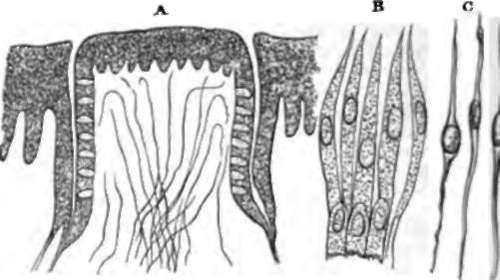166. The Sensory Nerves Of The Tongue
Description
This section is from the book "Animal Physiology: The Structure And Functions Of The Human Body", by John Cleland. Also available from Amazon: Animal Physiology, the Structure and Functions of the Human Body.
166. The Sensory Nerves Of The Tongue
The Sensory Nerves Of The Tongue end in a variety of ways. End-bulbs (p. 68) are found in the papilla? close to their extremities. Also, on the frog's tongue, nerves have been traced into elongated cells with forked extremities, situated in the epithelium; and although the mammalian tongue is very different from that of the frog, yet it is likely that some similar mode of nerve-termination is scattered over the tongue of the mammal also; for forked cells, continuous with nerve-fibres, have been described in the epidermis of general integument. But the most remarkable mode of nerve-termination found in the tongue is in the taste-conea of Schwalbe and Loven. These are structures which are fount nowhere else but on the protected sides of the circumvallati papillae. Each cone occupies the whole thickness of the epithelium; its base is on the papilla, its apex at the sur face, and its sides are convex. It consists of vertically placed nucleated cells running the whole length of the cone the outer of which are flattened like the staves of a barrel and form coats like those of an onion, while the inner an rod-shaped, and some of them with hair-like extremities, like the olfactory cells; and the group of these extremities at the top of each cone projects into the fossa round the papilla through a small opening left between the flattened superficial cells of the surrounding epithelium.

Fig. 112. Taste-Cones of Sheep. A, Vertical section of circum vallate papilla, exhibiting seven taste-cones on each side. B Outer cells of taste-cone. C, Inner cells. Schwalbe.
167. All tastes are not perceived by the same means. Astrin gents are perceived when applied to the fore part of the tongue, but not when applied to the back part. Bitters an perceived when applied to the back part, but do not affect the fore part. Sweet and saline tastes are perceived by means of both the fore and back part, but most acutely by the fore part. If sugar be laid on the tip of the tongue, the sweetness is at once perceived, though not so acutely as after pressing the tongue to the palate; but it may be rubbed into the back of the tongue, as also into the palate, without an; taste being detected till the palate and that part of the tongue are pressed together in swallowing. Perhaps the accurate pressure of the palate is necessary to bring the dissolved sugar into contact with the taste-cones.
In what is termed flavour, there is something more than mere taste. The texture of the substance tasted is an element which enters into flavour; for example, the smoothness, roughness, hardness, or softness; and these are appreciated by the acute common sensation in the tongue and palate. Smell is another element in flavour; and, besides that, many tastes and smells are so associated, that the smell brings the taste to mind, and certain aromatic tastes even suggest what seem in some way correspondent odours to the imagination. It is a matter of common observation, that interference with smell, as during an attack of catarrh, interferes with the power of distinguishing flavours.
There is another curious circumstance which points to a connection between taste and smell. In a number of mammals there is a sensory organ on each side of the septum of the nose, close to the floor, called the organ of Jacobson. It is a pouch lined with mucous membrane, receiving a twig from the olfactory nerve, and another from the source which supplies common sensation to the nose and palate; and its orifice is pointed downwards, so that in many animals it is most easily entered through a canal in the fore part of the palate. The use of this organ is hard to conceive; but it brings the distribution of the olfactory nerve very close to the organ of taste.
The back part of the tongue is supplied by the glossopharyngeal nerve, but the anterior three-fourths almost entirely by the gustatory branch of the fifth; and it is difficult to avoid the conclusion that both nerves are really nerves of taste.
Continue to:
- prev: 165. Taste
- Table of Contents
- next: 168. Vision
